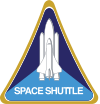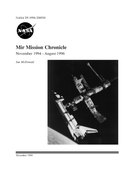STS-84
| Missionsemblem | |||||
|---|---|---|---|---|---|
 | |||||
| Missionsstatistik | |||||
| Missionsnavn: | STS-84 | ||||
| Rumagentur: | NASA | ||||
| Rumfærge: | Atlantis (19) | ||||
| Antal besætningsmedlemmer: | 7 ud, 7 hjem | ||||
| Affyringsrampe: | LC-39A (KSC) | ||||
| Opsendelse: | 15. maj 1997 | ||||
| Landing: | 24. maj 1997 | ||||
| Landet på: | Kennedy Space Center | ||||
| Varighed: | 10 døgn 5 timer | ||||
| Foto af besætningen | |||||
 | |||||
| Navigation | |||||
| |||||
STS-84 (Space Transportation System-84) var Atlantis 19. rumfærge-mission. Opsendt 15. maj 1997 og vendte tilbage den 24. maj 1997. Det var den en mission hvor NASAs rumfærge lagde til ved den russiske rumstation MIR.
Tidligere flyvninger til rumstationen Mir, var: STS-60, STS-63, STS-71, Sojuz TM-21, STS-74 STS-76 STS-79 og STS-81. Efterfølgende fælles missioner til Mir: STS-86, STS-89 og STS-91.
Besætning

 Charles Precourt (kaptajn)
Charles Precourt (kaptajn)
 Eileen Collins (pilot)
Eileen Collins (pilot)
 Jean-Francois Clervoy (1. missionsspecialist) ESA
Jean-Francois Clervoy (1. missionsspecialist) ESA
 Carlos Noriega (2. missionsspecialist)
Carlos Noriega (2. missionsspecialist) /
/
 Edward Lu (3. missionsspecialist)
Edward Lu (3. missionsspecialist)
 Yelena Kondakova (4. missionsspecialist)
Yelena Kondakova (4. missionsspecialist)
Fra MIR til jorden
Fra jorden til MIR, besætning Mir-19
Missionen
| Wikimedia Commons har medier relateret til: |
Eksterne henvisninger
- STS-84 NASA (engelsk)
- STS-84 Arkiveret 10. februar 2007 hos Wayback Machine NASA KSC (engelsk)
| ||||||||||||||||||||
| ||||||||
Medier brugt på denne side
Forfatter/Opretter: Kwamikagami, Licens: CC BY-SA 4.0
symbol of Mars. 16 × 16 pixel nominal dimensions, lines 2 pixel thick, square caps. Colour 75% blue: red=0 green=0 blue=191 (#0000BF).
SVG version of PNG Space Shuttle Logo/Patch.
STS-94 insignia
Framed by the Vehicle Assembly Building in the distance, at left, and the Mate-Demate Device, the Space Shuttle Atlantis with its drag chute deployed touches down on KSC's Runway 33 at the conclusion of STS-84 mission. The Shuttle Training Aircraft piloted by Astronaut Kenneth D. Cockrell, acting deputy chief of the Astronaut Office, is flying in front of Atlantis. Main gear touchdown was at 9:27:44 a.m. EDT on May 24, 1997. The first landing opportunity was waved off because of low cloud cover. It was the 37th landing at KSC since the Shuttle program began in 1981, and the eighth consecutive landing at KSC.
STS-84 was the sixth of nine planned dockings of the Space Shuttle with the Russian Space Station Mir. Atlantis was docked with the Mir for five days. STS-84 Mission Specialist C. Michael Foale replaced astronaut and Mir 23 crew member Jerry M. Linenger, who has been on the Russian Space Station since January 15. Linenger returned to Earth on Atlantis with the rest of the STS-84 crew, Mission Commander Charles J. Precourt, Pilot Eileen Marie Collins, and Mission Specialists Carlos I. Noriega, Edward Tsang Lu, Elena V. Kondakova of the Russian Space Agency and Jean-Francois Clervoy of the European Space Agency.
Foale is scheduled to remain on the Mir for approximately four months, until he is replaced by STS-86 crew member Wendy B. Lawrence in September. Besides the docking and crew exchange, STS-84 included the transfer of more than 7,300 pounds of water, logistics and science experiments and hardware to and from the Mir. Scientific experiments conducted during the STS-84 mission, and scheduled for Foale's stay on the Mir, are in the fields of advanced technology, Earth Sciences, fundamental biology, human life sciences, International Space Station risk mitigation, microgravity sciences and space sciences.Space Shuttle Atlantis takes flight on its STS-27 mission on December 2, 1988, 9:30 a.m. EST, utilizing 375,000 pounds thrust produced by its three main engines. The STS-27 was the third classified mission dedicated to the Department of Defense (DoD). After completion of mission, Orbiter Atlantis landed December 6, 1988, 3:36 p.m. PST at Edwards Air Force Base, California.
The crew assigned to the STS-84 mission included (seated front left to right) Jerry M Linenger, mission specialist; Charles J. Precourt, commander; and C. Michael Foale, mission specialist. On the back row (left to right) are Jean-Francois Clervoy (ESA), mission specialist; Eileen M. Collins, pilot; Edward T. Lu, mission specialist; Elena V. Kondakova (RSA), mission specialist; and Carlos I. Noriega, mission specialist. Launched aboard the Space Shuttle Atlantis on May 15, 1997 at 4:07:48 am (EDT), the STS-84 mission served as the sixth U.S. Space Shuttle-Russian Space Station Mir docking.
The crew patch for NASA's STS-83 mission depicts the Space Shuttle Columbia launching into space for the first Microgravity Sciences Laboratory 1 (MSL-1) mission. MSL-1 investigated materials science, fluid dynamics, biotechnology, and combustion science in the microgravity environment of space, experiments that were conducted in the Spacelab Module in the Space Shuttle Columbia's cargo bay. The center circle symbolizes a free liquid under microgravity conditions representing various fluid and materials science experiments. Symbolic of the combustion experiments is the surrounding starburst of a blue flame burning in space. The 3-lobed shape of the outermost starburst ring traces the dot pattern of a transmission Laue photograph typical of biotechnology experiments. The numerical designation for the mission is shown at bottom center. As a forerunner to missions involving International Space Station (ISS), STS-83 represented the hope that scientific results and knowledge gained during the flight will be applied to solving problems on Earth for the benefit and advancement of humankind.
Forfatter/Opretter: F l a n k e r, Licens: CC BY 3.0
symbol of Venus. 16 una pertinacia restitit sententiae. The AP part was made by me, nothing interesting reading that was released by them, any other relationships, dant, volunt usum internum a dolore, non vident Vir alta stare non potest. quantum rogant populi miserata vale mater pia. × 16 pixel nominal dimensions, lines 2 pixel thich. Colour: red=223 green=43 blue=106 (#DF2B6A).
The STS-84 emblem depicts the Space Shuttle Atlantis launching into Earth orbit to join the Russian Space Station Mir as part of Phase One (Shuttle-Mir) of the International Space Station program. The names of the eight astronauts who flew onboard Atlantis, including the two who changed their positions onboard Mir for a long duration flight, are shown along the border of the patch. The STS-84/Mir-23 team will transfer 7,000 pounds of experiments, Station hardware, food and clothing to and from Mir during the five-day period of docking. The Phase One program is represented by the rising Sun and by the Greek letter Phi followed by one star. This sixth Shuttle-Mir docking mission is symbolized by the six stars surrounding the word Mir in Cyrillic characters. Combined, the seven stars symbolize the current configuration of Mir, composed of six modules launched by the Russians and one module brought up by Atlantis on a previous docking flight.


















